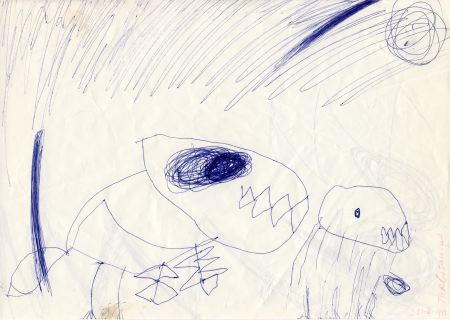Françesca’s fifth birthday is coming up in March.
Karl: Who do you want to see your drawings?
Fran: All the people from the whole world, and also grandma and grandpa.
a multi-disciplinary dialog
Françesca’s fifth birthday is coming up in March.
Karl: Who do you want to see your drawings?
Fran: All the people from the whole world, and also grandma and grandpa.

Not long ago, Françesca enjoyed typing random letters into a text editor for about ten minutes a day. Now that she is nearing five years old, that doesn’t satisfy her any longer. She learned how to use the mouse, and she’s beginning to understand how to use the Safari web browser. She can spend an hour on-line without a break.What to do? This is the point where Hanneke and I have a choice. We can take the computer away and have our kids grow up in a “traditional” pre-internet household. Or we can let them go online and accept the consequences.
I am of two minds about this. One view is that the kids should be able to grow up in an internet-free home, the way we grew up. The opposing view is that the kids should go online because the internet is part of the world we live in — keeping the kids away from it would be like refusing to let them learn to read or write.
I am torn between these two views, but I am leaning toward letting her go online because:
Anyone else out there with similar problems / opportunities?
 Recently we looked at one of Hanneke van Oosterhout‘s finished still life paintings. There were a number of excellent critiques. The painting was already sold, however, so comments could have no further impact on that picture.
Recently we looked at one of Hanneke van Oosterhout‘s finished still life paintings. There were a number of excellent critiques. The painting was already sold, however, so comments could have no further impact on that picture.
Now Hanneke is in the progress of making another still life. It is not yet finished, which means that your comments could help her make this painting better.
We can follow the painting’s development over several days. more… »

I recently asked how John Singer Sargent managed to capture the incredible sense of luminosity of the tent in A Tent in the Rockies. I’ve seen the painting in person; trust me, the interior of the tent looks even more luminous in the painting than it does in the web reproduction above.
Karl made two excellent comments about what’s going on, one dealing with contrast of chromaticity and one based on the viewer’s inferences about the tent material. I think those two comments are on the right track, but I also think there’s something else going on – I think Sargent is taking advantage of some quirky properties of the human visual system.
Check out this web page: http://web.mit.edu/persci/gaz/; if you don’t get the pop-up window (I didn’t) click on the ‘click here’ link as directed. Run the little animated demos, which are all about the sort of effect I thinking Sargent is using to good advantage. These demos (and the embedded explanations) are a fascinating exploration of some of the properties of our visual system.
It looks to me like Sargent has cleverly chosen the composition of this work to be similar to the ‘simultaneous contrast’ illusion – the bright, translucent area of the tent is cunningly surrounded by a region of darker ‘shaded’ canvas, so that the central portion seems even brighter.
I’ve found my minimal understanding of some of these effects to be useful when I’m adjusting a photo to be printed. I’d imagine they’d be similarly useful to any visual artist who has to contend with trying to eke out an expanded sense of brightness or darkness from a medium with fairly limited brightness range. Does the painting world know about this stuff and use it on an everyday basis?
I have to confess that I used to think of still-life as the most boring art from. Hanneke van Oosterhout’s paintings have raised my appreciation of ordinary everyday objects, which is nice. But her imaginary still-life drawings add a whole new level of intellectual and artistic interest for me in the still-life genre.
This drawing of a glass of beer is exciting despite being of a mundane topic. I think that working from imagination allows Hanneke to tap into a new level of creativity (sorry for the lousy pun).
Where she is going with this approach, what will be the final result, remains to be seen.
This snail doesn’t seem to like beer so much.